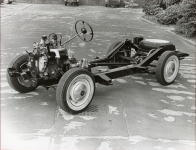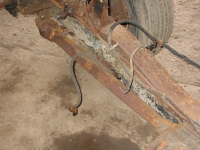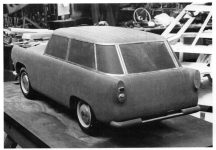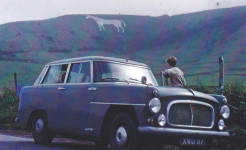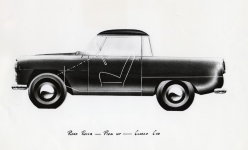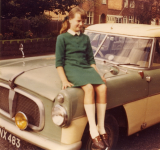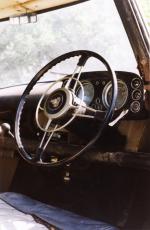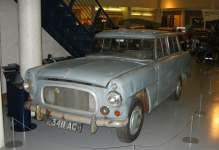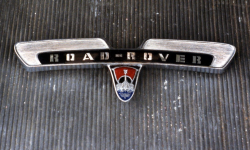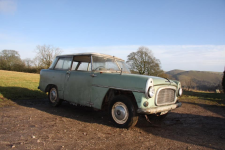another article from James Taylor - if you're on facebook you can follow his page here: https://www.facebook.com/james.t.roverphile
Some readers of this page recently showed an interest in the story of the Road-Rover, which is one of the largely forgotten parts of the Rover and Land Rover story. I first looked into it for my 1987 book on the Range Rover, and I’m sure I’ve done some updates in various magazines since then. Not recently, though – so here’s a run-down of the way the story looks at present. More new information does come to light from time to time, so there may be more to add to the story one day.
I ought to begin by pointing out that the Road-Rover was definitely not a direct ancestor of the Range Rover. The suggestion that it was has been muddied by the fact that an early mock-up of the Range Rover carried Road-Rover badging. This came about because the styling studio hadn’t yet been given a name for the new model but needed one to show what sort of badges they thought would work. They therefore resurrected one that they thought might be appropriate.
Also worth adding is that there were rumours a couple of years ago that Land Rover were developing a car-like relative of the then-current Range Rover that would be called the Road-Rover. That may have been true, but all the indications are that the project has since been cancelled. However, never say never…
THE ROAD-ROVER
The earliest traces of the Road-Rover appear in Rover records during 1951, when a full-size mock-up was built (probably mostly from wood) at Solihull. That date is quite significant, because by then the Tickford Station Wagon version of the Land Rover was on the way out. Having a coachbuilt body had made it too expensive for overseas customers (and the wooden frame tended to get eaten by termites in Africa, I’m told), and in the UK it attracted Purchase Tax as well, which made it ridiculously expensive.
However, Maurice Wilks was convinced that there was a market for a rugged station wagon-type vehicle. He seems to have decided to tackle it on two fronts. On the one hand, he encouraged his engineers to devise a station wagon that would use standard production Land Rover parts as far as possible (and that materialised in early 1954 on the 86-inch chassis). On the other, he thought that some customers would not want full off-road-capability but would prefer a more car-like estate. That was the Road-Rover, and he designed a very simple flat-panelled body for it, which he planned to put on a shortened Rover P4 saloon car chassis.
The first prototype, numbered RR1, was up and running in early April 1952 and was registered as MAC 162. We know that its chassis was from a 1952-season Rover 75 saloon, number 2436-0500. Those who saw it at Solihull christened it the Greenhouse for some fairly obvious reasons.
Four more prototypes to basically the same design were built in 1952. These were RR2 (not registered as UWD 563 until 1955), RR3 (MWD 711), RR4 (MWD 716) and RR5 (NAC 214). A fifth (RR6, NAC 930) was put on the road in March 1953 and seems to have been considered the definitive design. Certainly, a month later SB Wilks proposed to his fellow Directors that the Road-Rover should go into production, and the Rover Board approved a first tranche of expenditure on tooling.
The enthusiasm did not last. Three months later, the tooling finance was withdrawn, almost certainly because Rover was in danger of over-stretching itself while trying to get three new P4 saloon models and two new Land Rover models into production for the autumn. Road-Rover production was now proposed for “about June next year” – that is, June 1954.
The project was nevertheless kept alive with no fewer than six more prototypes, beginning in June 1953 and ending in July 1955. These were RR7 (NUE 665), RR8 (NWD 522), RR9 (OAC 816), RR10 (PNX 407), RR11 (PUE 41) and RR12 (SNX 36). RR11 was photographed wearing Land Rover wheels and tyres, and this has led some people to think that it had four-wheel drive. It did not: some pictures show quite clearly the independent front suspension of the P4 car range, although documents from July 1954 show that four-wheel drive layouts were certainly under consideration. Of these early-1950s prototypes, RR12 is the only known survivor, and belongs to the BMIHT Collection at Gaydon.
June 1954 had come and gone with no sign of Road-Rover production. The matter of finance for the project was raised again at a Rover Board meeting in March 1955, and in June that year SB Wilks suggested thinking about producing the Road-Rover again. At the time, Rover were negotiating with the Pressed Metal Corporation in Australia about CKD assembly there, and Wilks hoped that if this came off it would free up spare capacity at Solihull that the Road-Rover could use.
It was at about this time that the whole Road-Rover project was shaken up. It would be nice to think that David Bache, who was still fairly new as Rover’s one and only styling engineer, dropped a gentle hint to his boss that the existing Road-Rover design looked like a shed on wheels. However, Bache has insisted that he was not responsible for what happened next, and anyway at this stage he was far too busy working on the forthcoming Rover P5 (3-litre) and the Series II Land Rovers to get involved in yet another project.
One way or another, between mid-1955 and mid-1956 the Road-Rover body was completely redesigned to create what was known as the Series II version. Nobody knows who did it, but the finger points at Maurice Wilks himself, and he seems to have taken his inspiration from American station wagon styling of the day. The Series II has sometimes been described as looking like a shrunken Chevrolet – and therein was the problem. American station wagons were much larger than the Road-Rover, and their styling did not scale down very well. Interestingly, we know that Rover had a 1956-model Chevrolet Bel Air on their assessment fleet, which they sold off through Collier’s of Birmingham in August 1956, though I don’t know whether it was the station wagon version or not. Could this have provided inspiration?
At this stage, Rover were still sure the project had a future. In January 1956, more money was allocated to the Road-Rover and it looks as if the company intended to introduce it in 1957. The Series II cars were to have the new 2.25-litre petrol engine when that became available, but the first few prototypes had the same 2-litre IOE type as the earlier prototypes. The chassis frame had been redesigned to accommodate a P5-style torsion-bar front suspension, the wheelbase was fixed at 97 inches, and an overdrive was in the specification. Other body types – pick-ups and vans – were also sketched up at this stage, and all were to have aluminium alloy panels on a steel frame. Six more prototypes appear to have been built, although I have found no trace of two of them. The known ones were RR1/S2 (UUE 526), RR2/S2 (WNX 483), RR3/S2 (VWD 128), and RR5/S2 (WAC 620).
(The first three photographs show the Series I Road-Rover, first as a wooden mock-up, and then as prototype RR4; the third picture shows inside the rear of RR9. More pictures are in the Comments.)
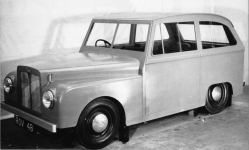
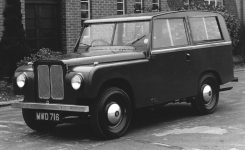
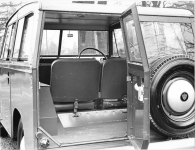
Some readers of this page recently showed an interest in the story of the Road-Rover, which is one of the largely forgotten parts of the Rover and Land Rover story. I first looked into it for my 1987 book on the Range Rover, and I’m sure I’ve done some updates in various magazines since then. Not recently, though – so here’s a run-down of the way the story looks at present. More new information does come to light from time to time, so there may be more to add to the story one day.
I ought to begin by pointing out that the Road-Rover was definitely not a direct ancestor of the Range Rover. The suggestion that it was has been muddied by the fact that an early mock-up of the Range Rover carried Road-Rover badging. This came about because the styling studio hadn’t yet been given a name for the new model but needed one to show what sort of badges they thought would work. They therefore resurrected one that they thought might be appropriate.
Also worth adding is that there were rumours a couple of years ago that Land Rover were developing a car-like relative of the then-current Range Rover that would be called the Road-Rover. That may have been true, but all the indications are that the project has since been cancelled. However, never say never…
THE ROAD-ROVER
The earliest traces of the Road-Rover appear in Rover records during 1951, when a full-size mock-up was built (probably mostly from wood) at Solihull. That date is quite significant, because by then the Tickford Station Wagon version of the Land Rover was on the way out. Having a coachbuilt body had made it too expensive for overseas customers (and the wooden frame tended to get eaten by termites in Africa, I’m told), and in the UK it attracted Purchase Tax as well, which made it ridiculously expensive.
However, Maurice Wilks was convinced that there was a market for a rugged station wagon-type vehicle. He seems to have decided to tackle it on two fronts. On the one hand, he encouraged his engineers to devise a station wagon that would use standard production Land Rover parts as far as possible (and that materialised in early 1954 on the 86-inch chassis). On the other, he thought that some customers would not want full off-road-capability but would prefer a more car-like estate. That was the Road-Rover, and he designed a very simple flat-panelled body for it, which he planned to put on a shortened Rover P4 saloon car chassis.
The first prototype, numbered RR1, was up and running in early April 1952 and was registered as MAC 162. We know that its chassis was from a 1952-season Rover 75 saloon, number 2436-0500. Those who saw it at Solihull christened it the Greenhouse for some fairly obvious reasons.
Four more prototypes to basically the same design were built in 1952. These were RR2 (not registered as UWD 563 until 1955), RR3 (MWD 711), RR4 (MWD 716) and RR5 (NAC 214). A fifth (RR6, NAC 930) was put on the road in March 1953 and seems to have been considered the definitive design. Certainly, a month later SB Wilks proposed to his fellow Directors that the Road-Rover should go into production, and the Rover Board approved a first tranche of expenditure on tooling.
The enthusiasm did not last. Three months later, the tooling finance was withdrawn, almost certainly because Rover was in danger of over-stretching itself while trying to get three new P4 saloon models and two new Land Rover models into production for the autumn. Road-Rover production was now proposed for “about June next year” – that is, June 1954.
The project was nevertheless kept alive with no fewer than six more prototypes, beginning in June 1953 and ending in July 1955. These were RR7 (NUE 665), RR8 (NWD 522), RR9 (OAC 816), RR10 (PNX 407), RR11 (PUE 41) and RR12 (SNX 36). RR11 was photographed wearing Land Rover wheels and tyres, and this has led some people to think that it had four-wheel drive. It did not: some pictures show quite clearly the independent front suspension of the P4 car range, although documents from July 1954 show that four-wheel drive layouts were certainly under consideration. Of these early-1950s prototypes, RR12 is the only known survivor, and belongs to the BMIHT Collection at Gaydon.
June 1954 had come and gone with no sign of Road-Rover production. The matter of finance for the project was raised again at a Rover Board meeting in March 1955, and in June that year SB Wilks suggested thinking about producing the Road-Rover again. At the time, Rover were negotiating with the Pressed Metal Corporation in Australia about CKD assembly there, and Wilks hoped that if this came off it would free up spare capacity at Solihull that the Road-Rover could use.
It was at about this time that the whole Road-Rover project was shaken up. It would be nice to think that David Bache, who was still fairly new as Rover’s one and only styling engineer, dropped a gentle hint to his boss that the existing Road-Rover design looked like a shed on wheels. However, Bache has insisted that he was not responsible for what happened next, and anyway at this stage he was far too busy working on the forthcoming Rover P5 (3-litre) and the Series II Land Rovers to get involved in yet another project.
One way or another, between mid-1955 and mid-1956 the Road-Rover body was completely redesigned to create what was known as the Series II version. Nobody knows who did it, but the finger points at Maurice Wilks himself, and he seems to have taken his inspiration from American station wagon styling of the day. The Series II has sometimes been described as looking like a shrunken Chevrolet – and therein was the problem. American station wagons were much larger than the Road-Rover, and their styling did not scale down very well. Interestingly, we know that Rover had a 1956-model Chevrolet Bel Air on their assessment fleet, which they sold off through Collier’s of Birmingham in August 1956, though I don’t know whether it was the station wagon version or not. Could this have provided inspiration?
At this stage, Rover were still sure the project had a future. In January 1956, more money was allocated to the Road-Rover and it looks as if the company intended to introduce it in 1957. The Series II cars were to have the new 2.25-litre petrol engine when that became available, but the first few prototypes had the same 2-litre IOE type as the earlier prototypes. The chassis frame had been redesigned to accommodate a P5-style torsion-bar front suspension, the wheelbase was fixed at 97 inches, and an overdrive was in the specification. Other body types – pick-ups and vans – were also sketched up at this stage, and all were to have aluminium alloy panels on a steel frame. Six more prototypes appear to have been built, although I have found no trace of two of them. The known ones were RR1/S2 (UUE 526), RR2/S2 (WNX 483), RR3/S2 (VWD 128), and RR5/S2 (WAC 620).
(The first three photographs show the Series I Road-Rover, first as a wooden mock-up, and then as prototype RR4; the third picture shows inside the rear of RR9. More pictures are in the Comments.)




